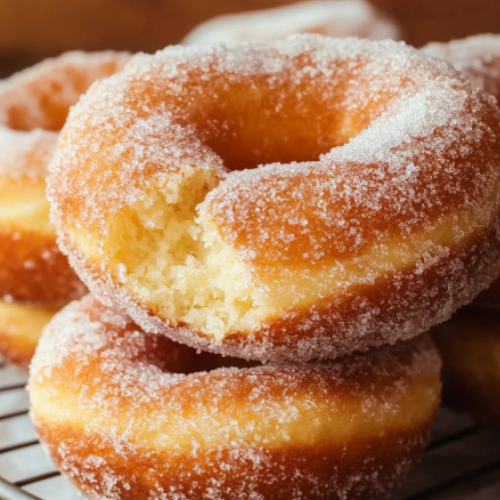Brioche donuts are rich, airy, and pillowy-soft treats made from a buttery yeast dough. These donuts are golden-fried and tossed in sugar for a delightfully crisp exterior and tender interior. Whether served plain or filled with your favorite creams, they’re a luxurious take on the classic donut.
Why You’ll Love This Recipe
These brioche donuts stand out for their incredibly soft and tender crumb, thanks to the enriched dough made with eggs, milk, and butter. Unlike regular donuts, the brioche dough offers a rich flavor and melt-in-your-mouth texture. Perfect for weekend baking or special occasions, they are just as impressive in flavor as they are in presentation. Plus, they’re versatile—enjoy them as-is or filled with custard, jam, or ganache.
ingredients
(Tip: You can find the complete list of ingredients and their measurements in the recipe card below.)
For the Dough:
- Bread flour
- Warm milk
- Large eggs
- Egg yolk
- Unsalted butter (softened)
- Granulated white sugar
- Instant yeast (or active dry yeast – see notes)
- Sea salt
- Neutral oil (vegetable, canola, or sunflower) for frying
For Garnish:
- Granulated sugar (for tossing)
directions
- Make the dough: In the bowl of a stand mixer, combine flour, sugar, yeast, and salt. Using the dough hook, begin mixing on low speed and add warm milk, eggs, and softened butter (one tablespoon at a time).
- Knead: Continue mixing on low for 8–10 minutes until the dough is soft, elastic, and tacky (not sticky). If the dough is too sticky, add a few spoonfuls of flour.
- First rise (bulk fermentation): Lightly oil the bowl and the dough surface. Cover with plastic wrap and a tea towel. Let rise in a warm place for 1 ½ hours, or until doubled in size.
- Shape the dough: Punch down the dough. Divide into equal portions—12 for extra large, 15 for large, or 20 for medium donuts. Shape each piece into a ball by tucking the edges under and rolling against the counter.
- Second rise (proofing): Place each dough ball on a pre-cut square of parchment paper. Cover with a damp tea towel and let rise for 30–40 minutes until puffy.
- Fry the donuts: In a heavy-bottomed pot or Dutch oven, heat oil to 350–355°F (176–179°C). Fry 3–4 donuts at a time, for 3–4 minutes per side. Adjust frying time slightly based on donut size.
- Drain and coat: Remove donuts using a slotted spoon and place on a wire rack or paper towel-lined tray. While still warm, toss in granulated sugar.
- Serve: Enjoy warm, plain or filled with custard, jam, or cream as desired.
Servings and timing
Servings: 12–20 donuts (depending on size)
Prep Time: 30 minutes
Rise Time: 2 hours
Cook Time: 8 minutes per batch
Total Time: Approximately 3 hours
Variations
- Filled Donuts: Once fried and cooled slightly, use a piping bag to fill with vanilla pastry cream, jam, lemon curd, or chocolate ganache.
- Cinnamon Sugar: Toss the donuts in cinnamon sugar instead of plain granulated sugar for added flavor.
- Powdered Sugar Finish: Dust with powdered sugar for a lighter sweetness.
- Glazed: Dip cooled donuts in a simple glaze of powdered sugar and milk for a shiny, sweet coating.
- Brioche Donut Holes: Use small dough portions to make bite-sized donut holes—perfect for parties or kids.
storage/reheating
Brioche donuts are best served fresh and warm. However, you can store leftovers at room temperature for 1–2 days. Wrap them in plastic wrap and a tea towel to retain moisture. Avoid refrigeration, as it can dry them out. Reheat briefly in a microwave (10–15 seconds) to restore softness. If preparing ahead, refrigerate any fillings separately and add just before serving.
FAQs
Can I use active dry yeast instead of instant yeast?
Yes. First, dissolve active dry yeast in the warm milk with a teaspoon of sugar and let it sit for 8–10 minutes until foamy. Then proceed with the recipe.
What’s the difference between brioche donuts and regular donuts?
Brioche donuts use an enriched dough with butter, eggs, and milk, resulting in a softer and richer texture.
How do I prevent the donuts from becoming greasy?
Maintain oil temperature between 350°F–355°F (176°C–179°C). Frying at too low a temperature will cause oil absorption.
Why do I need to proof the donuts twice?
The first proof develops flavor and structure; the second allows the shaped donuts to rise, creating a lighter texture when fried.
Can I freeze brioche donut dough?
Yes. After the first rise, shape the donuts and freeze them on a tray. Once frozen, transfer to a sealed bag. Thaw and proof before frying.
How do I know when the dough is ready to fry?
The donuts should be puffy and jiggle slightly when the tray is gently shaken.
What oil is best for frying?
Use a neutral oil with a high smoke point, such as canola, vegetable, or sunflower oil.
Can I bake instead of frying?
This recipe is designed for frying, which gives the classic brioche donut texture. Baking will produce a different, breadier result.
How do I fill donuts neatly?
Use a piping bag fitted with a round nozzle. Insert into the side or bottom of the donut and gently squeeze until filled.
Can I make the dough by hand?
Yes, though it requires more effort. Knead by hand for 12–15 minutes until smooth and elastic.
Conclusion
Brioche donuts are a bakery-worthy indulgence that you can make at home with simple ingredients and a bit of time. With their golden crust, fluffy interior, and customizable finishes, these donuts are sure to become a favorite for celebrations, brunches, or any time you want a truly special treat.


Your email address will not be published. Required fields are marked *